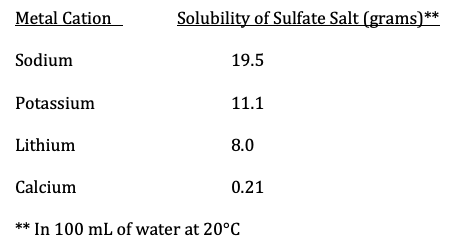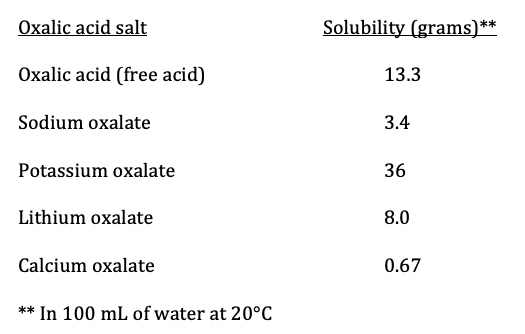Have you ever had a kidney stone? Your answer will be yes or no, not "I'm not sure." Just like the statement "I'm not sure whether I was just run over by a cement mixer" won't play. Both events lack subtlety. It is quite clear whether they happened or not.
Having gone this once I would cheerfully choose the cement mixer next time. Yes, it was that bad. And the pain doesn't come from what people assume - the stone getting stuck in your thingamabob when you're trying to pass it. Nope, it's when the stone gets caught in a ureter - one of the thin tubes that connect the kidney to the bladder. This causes incredibly painful spasms as the tube tries to squeeze out the stone. It also causes pressure to build up in the kidney, which can add nausea and vomiting to an otherwise thoroughly lovely experience.
In case that's not bad enough here's something worse - a chemistry lesson about kidney stones. Let's entitle it "The Aqueous Solubility of Various Calcium Salts at 25°C." With a title like that, how could you possibly not want to finish this hideous article?!? That is unless you have something better to do, like rearranging Q-Tips or making a mosaic from the toenail clippings collected from the floor of your mani-pedi parlor. In that case, you're excused. For the rest of you - just deal with it.
Most kidney stones are crystals composed of calcium oxalate, and it is both the calcium and the oxalate that contribute to the problem. Calcium salts (1) are often less water soluble than those other common metal ions, such as sodium and potassium (Table 1).

Table 1. The water solubility of four common sulfate salts @20°C
Sulfate (SO4-2), a common anion (negatively charged ion, was chosen because its solubility in water varies substantially depending on the cation (positively charged metal ion) it is paired with. Compared to sodium, potassium, and lithium sulfate, calcium sulfate is 40-100 times less soluble in water. The same trend is seen with other common anions, such as hydroxide, phosphate, and acetate. In each case, calcium salts are less soluble than those of the three other metals.
But oxalate, the anion of oxalic acid, brings with it its own set of problems, especially when paired with calcium. (Table 2).

Table 2. The water solubility of metal cations of oxalic acid @20°C. Oxalic acid itself is not an ion like its oxalate salts but is still water soluble. Solubility data for both tables is taken from the Wikipedia Solubility Table.
Now you can see why oxalic acid is not your friend. While its sodium, potassium, and lithium salts are freely soluble in water, the opposite is true when oxalate is paired with a calcium cation; the resulting salt, calcium oxalate, is what chemists call a "brick" - something that is difficult to dissolve. Calcium oxalate is about 5-50 times less soluble; it is so insoluble that only 0.67 grams (670 mg) of it will dissolve in 100 mL of water. So, when a calcium chloride (one example of Ca+2) and oxalic acid are each dissolved in water and then mixed, the reaction in Figure 1 occurs instantaneously forming the calcium oxalate which precipitates out of solution. This is how the stone begins to form.

Figure 1. The formation of calcium oxalate. Two soluble species, calcium ion, and oxalic acid react, forming insoluble (crystalline) calcium oxalate, which precipitates as a solid - the stone.
Here's the math. An average bladder holds about 400 mL of urine. Let's say that if you're dehydrated that volume is 200 mL. This means that only 1.34 g - roughly the weight of a pinch of sand (2) - will remain dissolved in that amount of urine (Table 2). (By contrast, 200 mL of urine will contain about 72 grams of sodium chloride.)
This is why the best defense against a kidney stone is to avoid becoming dehydrated. As urine becomes more concentrated, the concentration of calcium oxalate in the bladder will also increase. Since the stuff is so insoluble, when there is less water in the urine there is a greater chance that it will start to precipitate. Next thing you know you're writing on the ground begging for a quick death (3).
Summer is coming. Drink up and watch your diet. Certain foods contain higher amounts of oxalic acid (4). One of these is kale, in case you need another reason to avoid this vile weed.
NOTES:
(1) In chemistry, a salt is defined as the product the reaction between an acid and a base. For example, sodium hydroxide (lye, a base) reacts with hydrochloric acid to form sodium chloride, or with sulfuric acid to form sodium sulfate. This process is also known as neutralization.
(2) Small kidney stones are often described as the size of a grain of sand. Thought-provoking, no?
(3) The "precipitating" event that caused your idiot author to become so afflicted was two hours of playing hockey without drinking any fluids. Duh.
(4) The other way to prevent kidney stones is to avoid foods that contain a lot of oxalic acid. According to NYU Langone Health, "Calcium oxalate stones are linked with foods high in oxalate, which is a naturally occurring substance in plants and animals. These include beets, black tea, chocolate, nuts, potatoes, and spinach."
Conflict of Interest Statement: No matter what I write, the mutants over at US Right To Know (Nothing) will call me a shill and the mouthpiece of an industry group. So, I might as well admit it - ACSH is, indeed, a front group for "Big Stone." Some think that we have an abundance of them.




